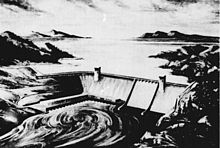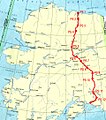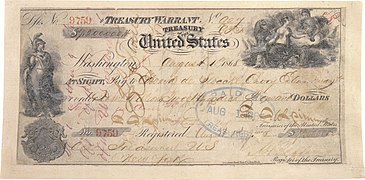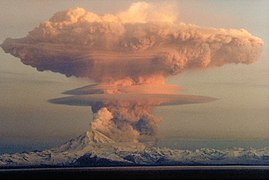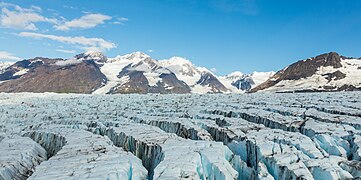
Back بوابة:ألاسكا Arabic Portal:Alyaska Azerbaijani Portal:Alaska Catalan Portal:Alaska German Portal:Alaska Spanish Portail:Alaska French Portal:Alasca Portuguese Portal:阿拉斯加州 Chinese
 Introduction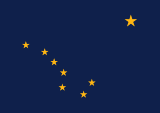   Alaska (/əˈlæskə/ ə-LASS-kə) is a non-contiguous U.S. state on the northwest extremity of North America. It is in the Western United States region and is considered to be the northernmost, westernmost, and easternmost (the Aleutian Islands cross the antimeridian into the eastern hemisphere) state in the United States. To the east, it borders Canada (the Yukon territory and the province of British Columbia). It shares a western maritime border, in the Bering Strait, with Russia's Chukotka Autonomous Okrug. The Chukchi and Beaufort Seas of the Arctic Ocean lie to the north and the Pacific Ocean lies to the south. Technically a semi-exclave of the U.S., it is the largest exclave in the world. Alaska is the largest U.S. state by area, comprising more total area than the next three largest states of Texas, California and Montana combined, and is the seventh-largest subnational division in the world. It is the third-least populous and most sparsely populated U.S. state, but is, with a population of 736,081 as of 2020, the continent's most populous territory located mostly north of the 60th parallel, with more than quadruple the combined populations of Northern Canada and Greenland. The state contains the four largest cities in the United States by area, including the state capital of Juneau. The state's most populous city is Anchorage and approximately half of Alaska's residents live within its metropolitan area. Indigenous people have lived in Alaska for thousands of years, and it is widely believed that the region served as the entry point for the initial settlement of North America by way of the Bering land bridge. The Russian Empire was the first to actively colonize the area beginning in the 18th century, eventually establishing Russian America, which spanned most of the current state, and promoted and maintained a native Alaskan Creole population. The expense and logistical difficulty of maintaining this distant possession prompted its sale to the U.S. in 1867 for US$7.2 million (equivalent to $157 million in 2023). The area went through several administrative changes before becoming organized as a territory on May 11, 1912. It was admitted as the 49th state of the U.S. on January 3, 1959. Abundant natural resources have enabled Alaska—with one of the smallest state economies—to have one of the highest per capita incomes, with commercial fishing, and the extraction of natural gas and oil, dominating Alaska's economy. U.S. Armed Forces bases and tourism also contribute to the economy; more than half the state is federally-owned land containing national forests, national parks, and wildlife refuges. It is among the most irreligious states, one of the first to legalize recreational marijuana, and is known for its libertarian-leaning political culture, generally supporting the Republican Party in national elections. The Indigenous population of Alaska is proportionally the second highest of any U.S. state, at over 15 percent, after only Hawaii. (Full article...) Entries here consist of Good and Featured articles, which meet a core set of high editorial standards.
The Rampart Dam or Rampart Canyon Dam was a project proposed in 1954 by the U.S. Army Corps of Engineers to dam the Yukon River in Alaska for hydroelectric power. The project was planned for Rampart Canyon (also known as Rampart Gorge) just 31 miles (50 km) southwest of the village of Rampart, Alaska, about 105 miles (169 km) west-northwest of Fairbanks. The resulting dam would have created a lake roughly the size of Lake Erie, making it the largest human-made reservoir in the world. The plan for the dam itself called for a concrete structure 530 feet (162 m) high with a top length of about 4,700 feet (1,430 m). The proposed power facilities would have consistently generated between 3.5 and 5.0 gigawatts of electricity, based on the flow of the river as it differs between winter and summer. Though supported by many politicians and businesses in Alaska, the project was canceled after objections were raised. Native Alaskans in the area protested the threatened loss of nine villages that would be flooded by the dam. Conservation groups abhorred the threatened flooding of the Yukon Flats, a large area of wetlands that provides a critical breeding ground for millions of waterfowl. Fiscal conservatives opposed the dam on the grounds of its large cost and limited benefit to Americans outside Alaska. (Full article...)TopicsCategoriesSelected article -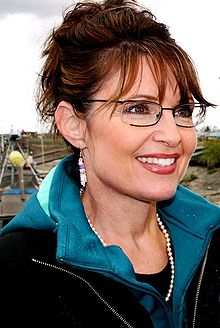 In 2006, Sarah Palin was elected governor of Alaska. Running on a clean-government platform, Palin defeated incumbent Governor Frank Murkowski in the Republican gubernatorial primary election in August. She then went on to win the general election in November, defeating former Governor Tony Knowles 48.3% to 40.9%. Her running mate was State Senator Sean Parnell. During the Republican gubernatorial primary campaign, Palin was endorsed by former Alaska Governor Walter Hickel, and groups such as the Alaska Correctional Officers Association and Alaska Right to Life. Later, in the general election for governor, she was supported by Governor Frank Murkowski. Republican U.S. Senator Ted Stevens made a last-moment endorsement, filming a television commercial with Palin for the gubernatorial campaign. During her campaign for governor, Palin declared that education, public safety, and transportation would be the three cornerstones of her administration. She won the race despite spending less than her Democratic opponent. (Full article...)Selected picture -General imagesThe following are images from various Alaska-related articles on Wikipedia.
Recognized content
Featured articlesGood articles
Featured pictures
Former featured pictures
Related Portals
Related WikiProjectsState facts
State symbols:
Tasks
Associated WikimediaThe following Wikimedia Foundation sister projects provide more on this subject:
Discover Wikipedia using portals |
© MMXXIII Rich X Search. We shall prevail. All rights reserved. Rich X Search
